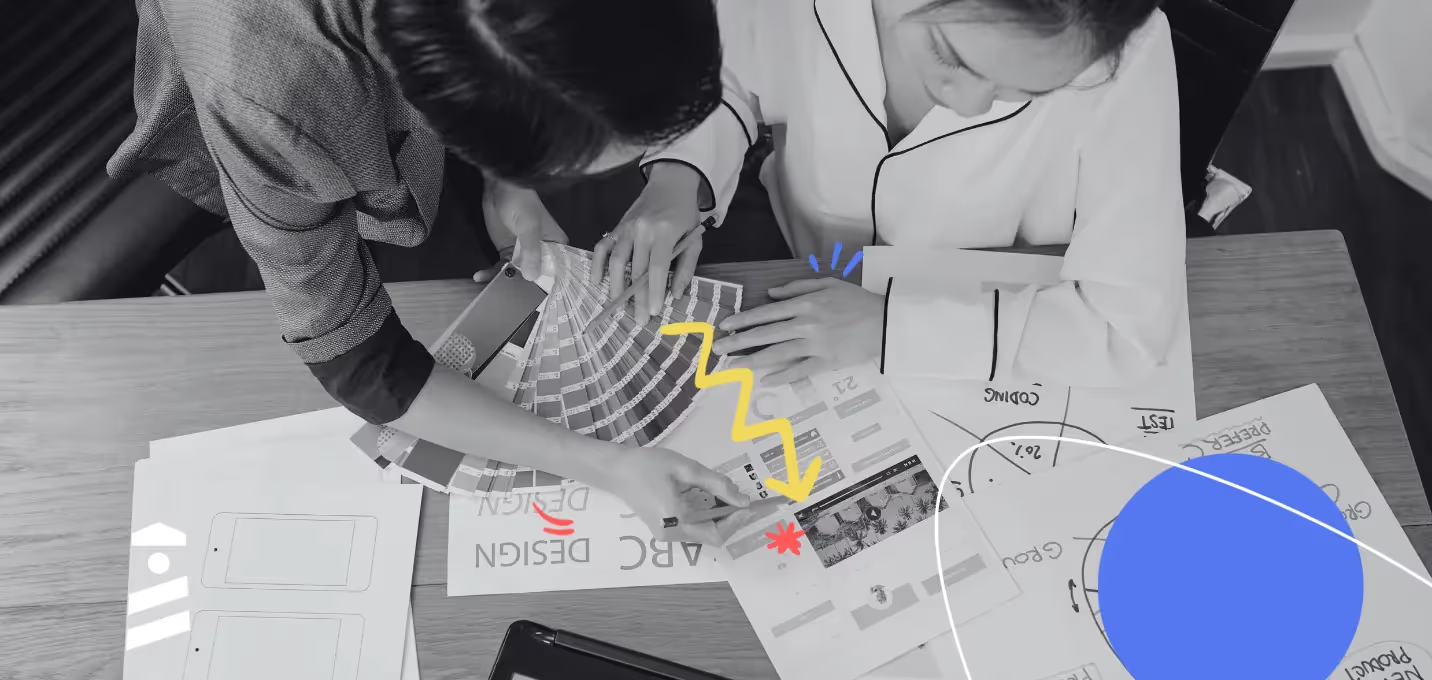

Are you a product manager interested in adding the basic principles of Design Thinking to your toolkit for career success? Check out this helpful article with a handful of easy-to-remember and juicy nuggets of info.
To be prudent, we will begin by quickly tap-dancing all over square one.
In General, What’s Design Thinking?
Simply put…
Design Thinking is applying principles of design to the way you develop products, services, internal/external processes, and your overall strategy.
We’ll get to those principles of design in due course, but first, let’s stick with big-picture definitions a moment. If we go straight to the proverbial horse’s mouth, IDEO, the quasi-founders of this methodology, here’s what we find:
“Design thinking brings together what is desirable from a human point of view with what is technologically feasible and economically viable. It also allows people who aren't trained as designers to use creative tools to address a vast range of challenges.”
Okay, great, matching what users need with what your budgeting and software can handle.
Nicely put.
Let’s get a second opinion from The Interaction Design Foundation:
“At the heart of Design Thinking is the intention to improve products by analyzing how users interact with them and investigating the conditions in which they operate. Design Thinking offers us a means of digging that bit deeper to uncover ways of improving user experiences.”
Right, so, what we’re talking about here is a human-centered, empathy-first ‘out of the box’ approach to certain aspects of being a Product Manager. The UX road less traveled. That being the case, what’s an ideal situation where a project manager like yourself could apply Design Thinking?
Typically complex challenges where you don’t yet have a comprehensive understanding of the problem and solution.

Need an example?
Sure thing...
Example Problem
Quickly Educating SaaS Users About New Features
While in the Design Thinking phase of UserGuiding software, this was one of the core problems we explored. It’s complex. At the time there were tons of ideas and solutions competing to be THEE industry-wide solution, but still, no standard or best practices exist.
Focusing on SaaS user desires, urges, wishes, delights, and frustrations, we set out to address the problem from their point of view. Our team in those days was almost expressly coders and programmers, so this gave us unique points of view.
- They guided us into some surprise twists and turns, as well as a handful of unexpected prototypes and test runs to see how assumptions faired in actual user-testing.
- Honestly, it worked wonders to step outside our technical comfort zones and look at solutions as conduits of user behaviors, habits, and adaptations.
Conversely, let’s switch gears and dip our toes into situations where Design Thinking isn’t your best bet.
What Design Thinking Is NOT
Hey there buckaroo, don’t stick your head in the sand and start thinking this is a one-size-fits-all ‘OMG we’re going to be insanely rich!’ solution for everything under the sun.
That’s a pipe dream... about to whack you upside the head with a hefty dose of reality.
To break it down, let’s use a small segment of Sebastian Brunetto’s article (he helped found Innovation Radicals) on Medium entitled “When to use Design Thinking And when NOT to?”
He starts off quite succinctly with,
“Don't use Design Thinking in processes that are not open-ended.”
Our core problem of quickly & effectively educating SaaS users on new features and updates is a perfect example.
How many problems or challenges are you facing that ARE open-ended?
How many involve educating and guiding users through software products?
Sebastian suggests Design Thinking is better as an,
“...exploratory approach used when the problem behind the problem isn’t really understood and a convincing solution isn’t obvious.”

In our case it was creating a lightweight overlay that works on top of your software, visually-intuitively walking users through step-by-step instructions. Or, highlights and spotlights to direct attention to new features, benefits, buttons, etc.
“Traditional strategy or management consultancies, for example, have the tendency to meticulously prepare and script stakeholder-workshops aiming to steer towards a desired outcome. Design Thinking does not work this way.”
Often there’s no possible way to hold a workshop - i.e. shoestring startups with immense amounts of talent but very little non-technical, user-centric understanding.
Sheesh, that’s some pretty dense topic material.
Let’s get to the point.
How to Apply Design Thinking in Product Management
The Product Management world was shell-shocked back in 2014 when the Design Management Institute (DMI) released this data point from their 10-year research:
Design-led companies outperform ‘low-design’ companies by 228%!
Yes, you read that right. there's no typo...228%.
That’s substantial...question is, do you think this number will increase or decrease throughout the 2020s?
Here at UserGuiding, we only see this number holding strong and steadily creeping upwards until there’s much greater industry-wide saturation of Design Thinking.
Let’s give you some helpful tips!
Tip #1: Aim for a Data-Backed Creative Process
By all means, grab a 6-foot tall by a 20-foot wide whiteboard, back in a truckload of markers and go to town brainstorming from the user perspective -- not just the PM’s, CEOs, COO’s, coders’ and programmers’.
- Is your team investing adequate resources into learning about target customers beyond the ‘traditional strategy or management consultancy’ approaches?
- What are the problems users face when they begin tangling with your software? How about adopting features? Learning about new updates?
Tom Jager writing for UserBrain, followed up the DMI’s research on Design-Led companies with findings from Adobe Research in April of 2019:
“According to the results of this study, these firms excelled at creating an emotional bond with customers (46% vs 32% of not design-led companies), often reinvented existing ideas, processes, and products (43% vs 27%), and spent more on innovation than competitors (41% vs 27%).”
Thing is, you’ve got to apply the ol’ 80/20 rule here. Meaning 80% of the results of your innovation investments, will come from 20% of your prototypes. The good news is, along with this kind of intense user-focus comes ultra-personalized solutions with great reach!
Tip #2: Work Towards Highly-Defined Actions
Imagine you could create an overlayed walkthrough that used on-screen highlighting to ensure your users know exactly what they’re doing when first using your software. You’ve seen this before. Many different platforms have their own versions, everything from large website-builders to gaming.
For the UserGuiding team, the challenge was satisfying the need for Project Managers like yourself to have access to tools like this...that DO NOT require any coding knowledge. Once this was highly-refined, we were able to trim, streamline, and adapt in ways only Design Thinking could inspire.
Tip #3: Find That ‘Sweet Spot’ Intersection
In her fantastic piece for Product School, Design Thinking in Product Management, Gabriela Araujo did a wonderful job describing where the approach fits into your career.
“The Design Thinking process is quite similar to the Agile methodology of Product Management,”
In other words, through this user-centric iterative process you’re a better problem solver. You’re able to navigate yourself, regardless of the particular SaaS you’re involved with, towards the intersection between Desirability, Feasibility, and Viability illustrated below by Product School:

Gabriela goes on to say,
“...as a matter of fact, Design Thinking helps to materialize the otherwise abstract concept by allowing ease of iteration and faster user-testing processes. Implementing design thinking in product management makes it easy to consider expedient user experience factors.”
My goodness, we’ve really dropped a string of mouthful-concepts on you here.
In closing...
Wrap Up: Testing & Reflecting Into Success
As begin brainstorming, building prototypes and testing theories, start by asking yourself these three critical questions:
- How does a designer reflect on their designs?
- How would users evaluate the performance of your product management team?
- Do you want to be a design-led company, and if so, how are you creating special bonds with your users?
Those get the juices flowing in the right direction. And here’s a quick bullet-point perspective of the important points we covered.
- What’s Design Thinking? Approaching Project Management using certain aspects of design-based thinking.
- What Is It NOT? A process well-suited for problems which aren’t open-ended.
- Aim for a Data-Back Creative Process: User data is the rallying point; the centers of gravity around which your more iterative and explorative processes should revolve.
- Work Towards Highly-Defined Actions: Get crazy-specific about the actions being taken to address open-ended problems & challenges.
- Find That ‘Sweet Spot Intersection: Your most astounding solutions will frequently arise from the intersection where Desirability, Feasibility, and Viability meet.

















.svg)
.svg)
.svg)
.svg)
.svg)

.svg)
.svg)












.svg)
.svg)




.png)

















